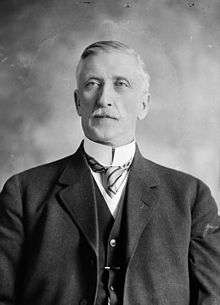Francis Cochrane
Francis Cochrane, PC (November 18, 1852 – September 22, 1919) was a Canadian politician.
Francis Cochrane | |
|---|---|
 | |
| MPP for Nipissing East | |
| In office 1905–1908 | |
| Preceded by | Charles Lamarche |
| Succeeded by | riding dissolved |
| MPP for Sudbury | |
| In office 1908–1911 | |
| Preceded by | first member |
| Succeeded by | Charles McCrea |
| MP for Nipissing | |
| In office 1911–1917 | |
| Preceded by | George Gordon |
| Succeeded by | Charles Robert Harrison |
| MP for Timiskaming | |
| In office 1917–1919 | |
| Preceded by | first member |
| Succeeded by | Angus McDonald |
| Personal details | |
| Born | November 18, 1852 Clarenceville, Quebec |
| Died | September 22, 1919 (aged 66) |
| Political party | Conservative |
| Residence | Sudbury, Ontario |
| Occupation | merchant |
Municipal career
A prosperous hardware merchant in Sudbury, Ontario, he was the first president of the town's board of trade and later served as mayor of the town in 1897, 1898 and 1902 [1] after winning a council seat in 1896.
Along with local businessman William McVittie, he subsequently invested in the Wahnapitae Power Company, which was contracted to provide the town's hydroelectricity services until it was sold to the Hydroelectric Power Commission of Ontario in 1929.[2] Cochrane and McVittie also ventured into prospecting, developing the Frood Extension property in 1908.[3]
Provincial career
Cochrane first ran for provincial office in 1902 as the Conservative Party candidate in Nipissing West in the 1902 election, but was defeated by Joseph Michaud. He did not run in the 1905 election, although Premier James P. Whitney nonetheless announced an intention to give him a cabinet portfolio. This appointment was delayed when Cochrane slipped while boarding a moving train in Sudbury and lost part of his right leg,[3] but in May of that year, Whitney transferred the Crown lands portfolio to a new Ministry of Lands, Forests and Mines and appointed Cochrane as the new minister. Cochrane was then acclaimed into office in a by-election in Nipissing East, succeeding Charles Lamarche.
He was reelected in the 1908 election in the new electoral district of Sudbury.
Federal career
Following the appointment of George Gordon to the Senate in 1911, Cochrane opted not to stand for re-election in the imminent 1911 provincial election, but instead stood as the Conservative candidate in the resulting federal by-election in Nipissing.
Cochrane served in Nipissing until 1917, and was Minister of Railways and Canals in the government of Sir Robert Borden from October 1911 until October 1917.
In 1917, he ran as the Unionist-Conservative candidate in the new district of Timiskaming. He was re-elected, and served as Minister without Portfolio until his death in 1919.
Honours
The town of Cochrane, Ontario was named for him.
References
- Dorian, Charles (1961). The First 75 Years, A Headline History of Sudbury, Canada. Arthur H. Stockwell Limited, Ilfracombe, Devon
- Wallace, C. M.; & Thomson, Ashley (Eds.) (1993). Sudbury: Rail Town to Regional Capital (3rd ed.). Dundram Press Limited. ISBN 978-1-55002-170-7
- Biography at the Dictionary of Canadian Biography Online